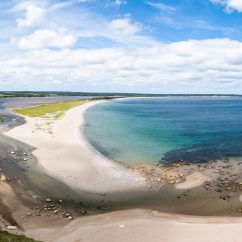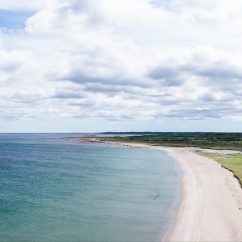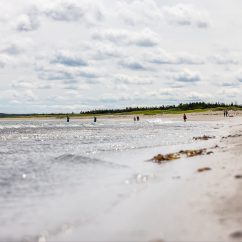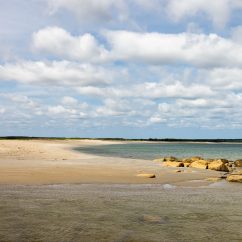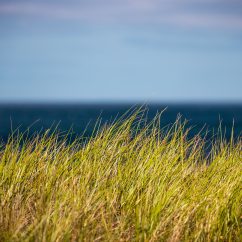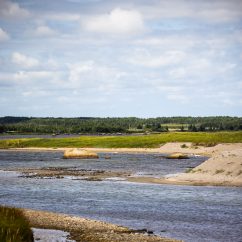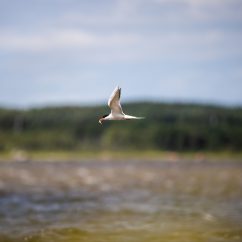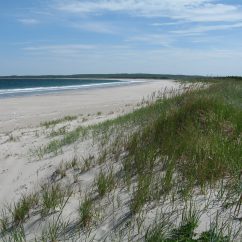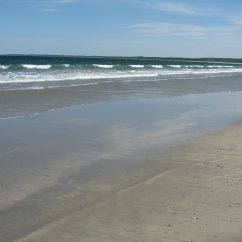Any province with over 20,000 kilometres of coastline has more than its fair share of bays, coves, inlets, harbours, points and peninsulas. Around here up is still up and down is still down but everything in between is anything but straight. That being said there is a straight stretch of coastline known as the Straight Shore near Lumsden on the north east coast of Newfoundland. Along this stretch there sits the foreboding-ly named Deadman’s Bay. The faint of heart needn’t worry; this park is anything but scary. Phenomenal would be a better way to describe the beautiful beach here. 72 hectares of fine white-beige sand that provides a fantastic view of icebergs in the summer.
Find out more about the park by visiting Natural History.
Photo Gallery
Activities
Beach
Deadman’s Bay features a beautiful shoreline covered with fine grain white or beige sand that reflects the sunset nearly as well as the ocean does! You can wade into the cool Atlantic ocean as you keep an eye out for mammoth icebergs slowly making their way past this unforgettable coast.
Bird Watching
Deadman’s Bay Provincial Park will keep the bird watcher busy. Here you can spot Ruddy Turnstones, terns and Bald Eagles. Be sure to bring your binoculars and listen for their calls.
Dog Walking
Dogs are welcome in all provincial parks and Deadman’s Bay is no exception. And with two and a half kilometres of beach to walk along and all that crisp, fresh sea air, it would be a real shame to leave your canine buddies behind. Be sure to clean up after your pet and, as this is an important area for shorebirds, keep them leashed at all times.
Hiking and Walking
The beach at Deadman’s Bay Provincial Park is a great place to explore, to lounge on a towel and, most certainly, a great place for a walk. The feel of your sandals sinking into the sand is simply delicious. Listen to the rhythm of the lapping waves as you enjoy a relaxing stroll along this two and a half kilometre beach.
Photography
This gorgeous beach makes an excellent backdrop for the enthusiast photographer. Once the sun starts reflecting off the water and the sand alike and the waves start crashing against the shore, you’ll want to start capturing. And you won’t be long filling up an SD card!
Picnics
After strolling this two and a half kilometre beach, you’ll want to stop and soak up the natural beauty. Pack some snacks, and treat yourself to a feast for the body and the soul.
Stargazing
When the sun sets the light show begins. The lack of artificial light in these parts means you’ll have no trouble spotting your favourite constellations as the stars twinkle and shine down from above. Bring along a telescope and take it all in.
Wildlife Watching
If it feels like you aren’t alone, you’re right! Otters may be fishing and it’s easy to mistake them for the smaller mink that also roam this park. Look for evidence of the snowshoe hare, such as chewed twigs along pathways. Foxes have also been spotted here and look for bats at dusk. The best time to experience wildlife in the park is in the morning or evening; keep quiet and keep your eyes peeled.
Prohibitions
Do Not Disturb
Please note that everything in a provincial park is protected; from the smallest rock to the largest tree. For that reason, introducing and/or removing any natural items is prohibited.
No Campfires
No Camping
No Cutting Trees
No Hunting
No Off-road Vehicles
Off-road vehicles include any motorized vehicles that are not legally permitted for use on provincial highways.
No Snowmobiles
Services
Cell Service
Cell service is available within this park.
Parking
There is parking available in this park.
Natural History
Deadman’s Bay Provincial Park’s is located within the Eastern Hyper-oceanic Barrens ecoregion and its biggest feature would have to be the two and a half kilometre stretch of white-beige sandy beach. Here you can wade into the cool Atlantic Ocean and keep an eye out for mammoth icebergs as they make their way past this beautiful coast. Nearby landmarks of the same name include the barachois channel, Deadman’s Gut, and the brook that feeds into it, Deadman’s Brook that runs out of the forest from Deadman’s Pond. And further up the coast you’ll find the point known as Deadman’s Rock.
Wildlife abound here with salmon angling to be enjoyed, although otters in the area may be competing with you! Foxes, moose, mink and snowshoe hare can all be spotted.
Historically, the beaches at Deadman’s Bay Provincial Park have been a nesting ground of the endangered Piping Plover. Less than thirty pairs of this migratory shorebird frequent Newfoundland and Labrador between May and August each year. These days they nest on the beaches at Sandbanks Provincial Park and J.T. Cheeseman Provincial Park. That being said, if you spot a small pale shorebird with a distinctive peeping call in Deadman’s Bay, do not disturb it and be sure to report it to park officials.
For additional information on the natural history of this park, please refer to the Eastern Hyper-oceanic Barrens ecoregion brochure.


